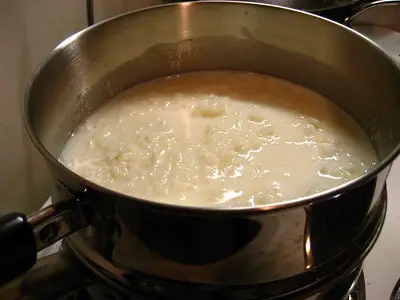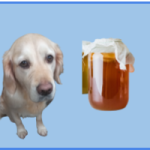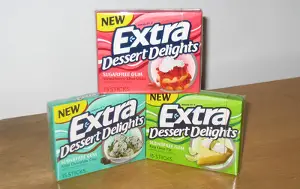Your dog can eat rice pudding.
I have looked at lots of recipes for homemade rice pudding and some popular products you can buy at your local shops and none of the ingredients are toxic to your dog.
But rice pudding doesn’t play a part in any healthy dog diet and so it should be fed as a very occasional treat in small quantities to your dog.
And if you do want to feed it as a treat be prepared to clear up from a dose of diarrhea caused by the high sugar and milk content.
Rice pudding is one of those old fashioned desserts that is often eaten with a topping.
Or if you like to buy ready to eat pots of rice pudding, they come in different flavours.
The worst effect that most toppings or flavourings will have is to upset your dog’s stomach.
But there are some they could kill your dog and these include raisins or chocolate.
But in the next section, I will look at what ingredients are used to make rice pudding.
What are the main ingredients of rice pudding?
At it purest, rice pudding should just be made with:
- Rice
- Milk
- Eggs
- Butter
- Sugar
A quick look at those ingredients soon tells us that there is nothing there that will poison your dog.
Egg and milk are the stand out ingredient as far as nutrition goes, the rest just offer either carbs or calories.
But let me take you through them one by one.
Rice
Did you know that white rice has over 300 calories per 100g serving?
And that it is 79% carbohydrate?!
In fairness to plain white rice, it does provide some serious amounts of vitamins B5 and B6 both of which are important in turning food into energy.
And it also delivers on the mineral front.
Containing as it does lots of copper (vital for red blood cells) and a little known substance called manganese (which helps with reducing inflammation and keeping our bones in top condition.)
Rice is also used in many dog foods and as a home remedy for when your dog has a dodgy tummy.
Milk
Although it will probably be highly unlikely, dogs that are lactose intolerant shouldn’t go near dairy products.
Growing up in Britain, we were all led to believe that as far as nutrition goes, milk is a great source of calcium.
Which is important for healthy bones.
But milk offers so much more.
It contains lots of B vitamins B2 and vitamin B12 in particular.
B vitamins are important for lots of things including how food is converted into energy.
And although it does contain lots of calcium it is also a good source for phosphorus.
And guess what? Phosphorus along with calcium will help maintain your dog’s teeth and bones.
Eggs
Eggs are nearly 10% fat and 13% protein.
They also contain huge amounts of some key B vitamins- B5 as well as our old friends B5 and B12.
And since we know what role B vitamins play in our dogs, I won’t repeat myself.
Eggs are also a great source for selenium, have you heard of it?
One of the key roles that it plays in your dog’s body is in making sure that their thyroid works properly.
Because eggs contain so much protein they are a great source for amino acids, which are fundamental to your dog’s well being.
Among other things, amino acids control hormones.
Butter
Butter is 81% fat.
The overwhelming majority of these fats are saturated, some are unsaturated and a few are polyunsaturated.
I am not going to get into a debate about healthy vs unhealthy fats.
Clearly, the less fat that most dogs have in their diet the better.
Sugar
I don’t think that I need to spend time here looking at what nutrition sugar adds to a dog’s diet as it doesn’t.
Too much of it just adds more to their waistlines and just adds more cavities in their mouths.
Having looked at what ingredients are used in traditional rice pudding, I want to now look at some of the “sweet garnishes” that are sometimes added.
And whether these are safe for your dog to eat.
What are the most commonly used extra ingredients?
Off the top of my head, I can think of four common toppings that people might garnish their rice puddings with.
And they are:
- Vanilla extract
- Cinnamon
- Jam
- Raisins
Of these four toppings, two are “dog friendly”, one is borderline dangerous and one is very dangerous.
Let me explain this is reverse order, starting with the most dangerous.
And the greatest threat comes from raisins, would you believe it?
Now some dogs can eat raisins and grapes with immunity, whilst to other dogs a handful of raisins might lead to an emergency appointment with the vet.
And no one really knows why this is- scientists have yet to isolate the chemical within a raisin that causes so much trouble.
Slightly less troubling, but still a topping to avoid when your dog is around, is vanilla extract.
Did you know that vanilla extract is 35% alcohol? I had no idea…
Now obviously the amount of vanilla extract used in rice pudding is relatively small but it is good information to be aware of.
Next on my list is jam.
Now most jams are “fine” for a dog to eat as long as we understand that jam is mostly sugar and that sugar has no nutritional value.
In which case you might already be crossing it off your list…
But some sugar free jams could potentially kill your dog.
And these are sugar free jams that use an ingredient called xylitol.
If you like a spoonful of sugar free jam on your rice pudding, please look at the ingredients very carefully.
And so to cinnamon.
No don’t worry, there aren’t any hesitations with sprinkling cinnamon on your rice pudding.
It is a 100% dog safe ingredient.
Cinnamon is 53% dietary fibre.
I have never heard of anyone using it to help with their dogs’s digestion, have you?
And it contains an absolutely massive amount of the mineral manganese which is important for your dog’s fight against disease.
To recap, if you want to add a topping with your rice pudding, cinnamon is your safest bet whereas raisins are things that you must never be tempted to use with your dog.
So far in this guide, I have looked at rice pudding from the angle of making it yourself at home, but next I will look at a couple of ready to eat rice puddings.
Can dogs eat tinned rice pudding?
One of the best selling tins of rice pudding is Ambrosia.
The ingredients list is as follows: full cream milk, skimmed milk, whey, rice (9%) and sugar.
Whey is an interesting ingredient because it is a protein that is in milk already and so it is added into foods to give them extra protein.
On the one hand none of these ingredients are toxic for your dog but on the other hand none of the ingredients will add much benefit to your dog’s diet either.
So tinned rice pudding is a harmless treat if given to your dog every so often in small quantities.
But it wouldn’t be an ideal food to add to your dog’s diet on a regular basis.
Can dogs eat flavoured rice puddings?
In the UK and the US, there is a range of flavoured rice puddings available.
In the UK, they are made by companies such as Muller.
And In the US they are made by companies such as Sun Tropics.
The Muller Rice range includes; strawberry, vanilla custard, original, apple and chocolate.
Sun Tropic makes a range of coconut rice puddings combined with different flavours.
These flavours include: chocolate, cinnamon and salted caramel.
The ingredients list for both the Muller pots and Sun Tropics are pretty similar and contain lots of milk products, a bit of rice (7%) and lots of sugar and sweeteners.
None of these products from either company are ideal to feed to your dog.
The most damage that most of these flavours will do to your dog is a touch of diarrhea.
But the chocolate flavours have the potential to poison and do real harm to your dog.
Dogs are allergic to a chemical found in chocolate and so even a spoonful from these pots is too much.
Can puppies be weaned using rice pudding?
The quick answer to this question is “no.”
And for two very good reasons.
Firstly rice pudding is made with cow’s milk which puppies really struggle to digest.
Cow’s milk has lots of lactose (milk protein) that puppies can’t digest very well.
If puppies need to be fed milk, it should be a milk such as goat’s milk, which is much lower in lactose.
So unless you want to make some at home using goat’s milk, using rice pudding with your puppy is not advised.
Secondly, when it comes to weaning ideally you want the puppy to be eating the food that they will be eating for the next few months.
Such as a high protein kibble specially formulated for puppies.
So when we wean our puppies we feed them with a puppy kibble which is soaked in warm water.
Rice pudding just isn’t nutritious enough to be fed to a puppy regularly.







